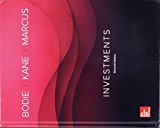
a
Adequate information:
Expected rate of
Standard deviation of the risky asset=28%
T-bill rate is 8%
Client’s degree of risk aversion A=3.5
To compute: The proportion of Y of the total investment
Introduction:
Portfolio optimization: When an investor has to select the best portfolio or asset distribution from the given set of portfolios, he/she has to very careful as his purpose or objective of investing should be fulfilled. So, the process involving this activity can be termed as Portfolio optimization. By proper planning and calculations, the risk factor can be decreased and thereby increasing the returns.
b
Adequate information:
Expected
Standard deviation of the risky asset=28%
T-bill rate is 8%
Client’s degree of risk aversion A=3.5
To compute: The expected rate of return and the standard deviation of the enhanced portfolio related to client.
Introduction:
Portfolio optimization: When an investor has to select the best portfolio or asset distribution from the given set of portfolios, he/she has to very careful as his purpose or objective of investing should be fulfilled. So, the process involving this activity can be termed as Portfolio optimization. By proper planning and calculations, the risk factor can be decreased and thereby increasing the returns.
Want to see the full answer?
Check out a sample textbook solution
Chapter 6 Solutions
Investments, 11th Edition (exclude Access Card)
- If a bond has a coupon rate lower than the market interest rate, the bond will sell at:A) Par valueB) A premiumC) A discountD) Its face valuearrow_forwardThe primary objective of financial accounting is to:a) Provide management with detailed reports for decision-making.b) Help the company save taxes.c) Provide financial information to external users.d) Track inventory levels. please help.arrow_forwardWhich of the following is an example of a capital budgeting decision?A) Determining the amount of inventory to keep on handB) Deciding whether to purchase a new piece of machineryC) Setting the credit terms for customersD) Deciding how much cash to keep in the bankarrow_forward
- For pueblo super market in st thomas usviarrow_forwardWhat is the methodology that capital markets serve as engines of economic growth and innovation? Could you help explain how methodology is critical to successful of the capital market? How are they also vulnerable to significant structural and behavioral problems? What are the appropriate uses of a qualitative single case study, and what types of research are best suited for the study of capital markets? What is the research framework of the capital market?arrow_forwardWhat is the purpose of the Capital Markets? What are the qualitative research questions that Capital Markets seek to understand or explain, while quantitative research questions seek to relate or measure? What could be the problems of Capital Markets, and how can the problems of Capital Markets be solved? How can the practice or issue be improved?arrow_forward
- What are the obstacles to work through emotional wellness coping methods, and increasing self-understanding, and how to work through them? What are the advantages and disadvantages of emotional wellness, coping methods, and increasing self-understanding?arrow_forwardWhat is the present value of $10,000 to be received in 5 years, assuming a discount rate of 10%?A) $6,210B) $6,810C) $7,580D) $8,100arrow_forwardDepreciation is:a) The increase in the value of an asset over time.b) The allocation of the cost of a tangible asset over its useful life.c) An amount paid for the maintenance of an asset.d) An asset's market value at the end of the accounting period.arrow_forward
- Depreciation is:a) The increase in the value of an asset over time.b) The allocation of the cost of a tangible asset over its useful life.c) An amount paid for the maintenance of an asset.d) An asset's market value at the end of the accounting period. Need helparrow_forwardWhat is the corporate finance how this is the part of finance?arrow_forwardExplain! Which of the following represents the primary goal of financial management?A) Maximizing net incomeB) Maximizing shareholder wealthC) Minimizing costsD) Maximizing market sharearrow_forward
 EBK CONTEMPORARY FINANCIAL MANAGEMENTFinanceISBN:9781337514835Author:MOYERPublisher:CENGAGE LEARNING - CONSIGNMENT
EBK CONTEMPORARY FINANCIAL MANAGEMENTFinanceISBN:9781337514835Author:MOYERPublisher:CENGAGE LEARNING - CONSIGNMENT
